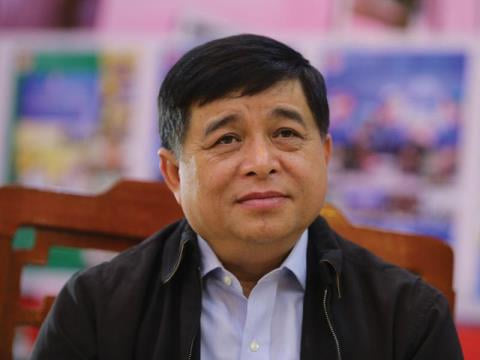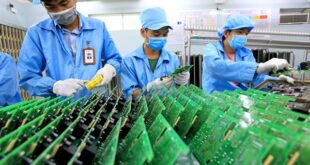
Minister of Planning and Investment Nguyễn Chí Dũng talks to the Vietnam News Agency about the key objectives and priorities of Việt Nam socio-economic recovery programme for 2022. The VNĐ350 trillion (US$15.42 billion) programme, the largest in history, aims to reboot and speed up the country’s economy after a long period of social and mobility restrictions, due to the COVID-19 pandemic.
What are the main objectives of the recently approved socio-economic recovery programme, which was designed by the Ministry of Planning and Investment?
Việt Nam’s socio-economic recovery programme was designed based on the country’s ability to procure vaccines and medical supplies, with great emphasis on providing support to businesses and workers, especially those who have been severely affected by the pandemic.
We hope to see steady GDP growth of 6.5-7 per cent annually during the 2021-25 period, with a sustainable level of income, stable macro-economics and adequate support given to low-income households and vulnerable groups.
The programme aims to improve businesses’ resilience, with priority given to the development of key infrastructure projects under the public-private partnership model. Meanwhile, the Government is to continue rolling out reforms to streamline and improve administration, investment environment, risk management and strengthen macro-economic stability.
A lot of thought has been put into the design of government support for the business sector, as we must balance elements of fiscal policies, socio-economic development as well as the short-term and long-term impact on the economy.
At the core of our socio-economic recovery is the business sector’s competency and its ability to change and adapt to the new environment.
What lessons were drawn from international experience and successful model in the design of the programme?
The pandemic has forced governments to issue huge stimulus packages, at times at the expense of fiscal discipline and rising levels of public debt, to get the economy back on track. Most governments prioritise improving medical facilities, welfare programmes, investments in infrastructure and immediate support for hard-hit sectors of the economy. Notably, common practices include credit extensions and more relaxed financial regulations.
The last time we rolled out a large stimulus package was in 2008, during the global financial crisis. The $6.9 billion package helped Việt Nam’s economy not only quickly recover, but also register positive growth, a rare occurrence at the time.
Valuable lessons on what not to do and the negative impacts on the economy of the 2008 stimulus package have been studied in depth.
This time around, our design aims at stimulating the economy, productivity and providing social support, while maintaining a balance among fiscal policies, interest rate and cash injection, to minimise the risk of rampant real-estate speculation and high inflation.
Support for the business sector must go hand-in-hand with helping them find new markets and consumers. Measures must also be put in place to prevent abuses and exploitation. For example, firms eligible for financial support may opt to deposit the cash for short-term interest payouts rather than invest in themselves. It was one of many lessons we learned in 2008. The effect was fully felt in 2011 as Việt Nam’s inflation hit 18.6 per cent and we still have to repair a lot of damage since that time, even today.
What are the main driving forces behind Việt Nam’s socio-economic recovery for 2022?
The first and highest priority in 2022 is to vaccinate the population, especially our labour force, to make sure we have the manpower to fuel the country’s socio-economic recovery. The Government must speed up and improve the efficiency of public investment with a focus on key economic sectors, transport infrastructure and inter-regional connectivity projects.
The pandemic has forced us to commit to and hasten the economic restructuring process to better integrate into the global value chain, make better use of our resources and produce higher quality products to compete. It has been a wake-up call for us to build a comprehensive strategy to force collaboration among economic regions to replace the old mindset of “competing against each other”.
Another key element is the numerous free trade agreements we have signed. It’s the Government responsibility to provide businesses with guidance and support to make the most out of said agreements, to boost exports and gain access to foreign markets. Meanwhile, improving inter-regional connectivity, ensuring supply and boosting demand are seen as key factors to revive demand of the domestic market.
What is the decisive factor of the socio-economic recovery programme in your opinion?
I believe the single most important factor that will decide the outcome of the programme is how much support it garners from the business sector and the population. So far, we have reason to believe the majority of firms and the population are supportive of the Government’s efforts to check the spread of the virus, while maintaining somewhat limited socio-economic activities.
We have also seen major efforts by Vietnamese firms to seek out new markets, to adopt new and better technologies, especially digital assets, and to overcome difficulties. This is a welcome sign, as the country relies heavily on the business sector to spearhead an economic rebound once social and mobility restrictions can be relaxed, or removed altogether.
Businesses can count on the Government to continue with the implementation of numerous support tools, including the credit extension, reduction or waiving of fees and land-use tax, as well as lower interest rates from commercial banks.
On the other hand, we encourage businesses to start their own reforms, aimed at improving their ability to compete, quality of products and services, human resources and management capacity. VnExpress News
- Reduce Hair Loss with PURA D’OR Gold Label Shampoo
- Castor Oil Has Made a “Huge” Difference With Hair and Brow Growth
- Excessive hair loss in men: Signs of illness that cannot be subjective
- Dịch Vụ SEO Website ở Los Angeles, CA: đưa trang web doanh nghiệp bạn lên top Google
- Nails Salon Sierra Madre
 VnExpress News The News Gateway of Vietnam
VnExpress News The News Gateway of Vietnam





